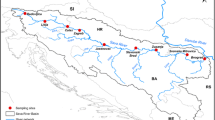Abstract
In order to evaluate the possible radiological impact to the local public and environment from a phosphogypsum stockpile, 210Po and 210Pb concentrations in river water, lagoon water, suspended matter, superficial sediment, algae and bivalves samples collected in Venice lagoon area have been investigated. The results show that the mean 210Po and 210Pb concentrations in river water are 1.42±0.36 mBq.l-1 and 1.46±0.39 mBq.l-1 with a mean 210Po/210Pb ratio of 0.98±0.17 and about 60% of them are associated with the particulate; 210Po and 210Pb contribution from the phosphogypsum stockpile to the river water is negligible. Higher 210Po (2.61-5.67 mBq.l-1) and 210Pb (1.31-3.62 mBq.l-1) concentrations in the lagoon waters have been observed if compared with the literature values. About 60% of 210Po and 210Pb are found in the soluble form with a mean 210Po/210Pb ratio of 1.79±1.47. 210Po and 210Pb concentrations in 28 out 37 sediment samples ranged from 26 to 45 Bq.kg-1 (dry weight), only 9 sediments with 210Po and 210Pb concentrations greater than 45 Bq.kg-1 are found and most of them are located 1-4 km near the phosphogypsum stockpile. The elevated 210Po and 210Pb concentrations in the sediments may be due to the contamination from the phosphogypsum stockpile. The mean 210Po/210Pb ratio (0.986±0.049) in the sediments shows that 210Po and 210Pb exist in nearly secular equilibrium. 210Po and 210Pb concentrations in algae vary with different species. The mean 210Po and 210Pb concentrations in Gracilaria compress and Ulva laetevirens which show a similar behavior, are 3.18±1.23 Bq.kg-1 and 2.42±1.26 Bq.kg-1 (fresh weight), respectively, with a mean 210Po/210Pb ratio of 1.45±0.34. The mean concentration factors with respect to the filtered water are 1096±424 for 210Po and 1299±680 for 210Pb. The mean 210Po and 210Pb concentrations in the soft part of Mytilus edulis are 23.2±9.7 Bq.kg-1 and 0.537±0.203 Bq.kg-1 (fresh weight), respectively, with a mean 210Po/210Pb ratio of 43.6±10.0. The mean concentration factors with respect to the filtered water are 8006±3351 for 210Po and 290±109 for 210Pb, showing a very high accumulation effect for 210Po. The accumulation behaviors of Cerastoderma glaucum and Tapes philippinarum for 210Po are similar to Mytilus edulis, but that for 210Pb seems less effective, corresponding to a relatively higher 210Po/210Pb ratio. The estimated committed effective doses from 210Po for the individual local public through ingestion of bivalves are in the range of 0.050-0.231 mSv.y-1.
Similar content being viewed by others
References
A. Martinez-Aguirre, M. Garcia-Leon, J. Environ. Radioact., 22 (1994) 155.
H. W. KÖster, P. A. Marwitz, G. W. Berger, A. W. Van Weers, P. Hagel, J. Nieuwenhuize, Radiat. Prot. Dosim., 45 (1992) 715.
P. M. Rutherford, M. J. Dudas, R. A. Samek, Sci. Total Environ., 149 (1994) 1.
C. D. Hull, W. C. Burnett, J. Environ. Radioact., 32 (1996) 213.
F. P. Carvalho, Sci. Total Environ., 159 (1995) 201.
C. Testa, D. Desideri, F. Guerra, M. A. Meli, C. Roselli, S. Degetto, Czechosl. J. Phys., 49 (1999) 649, Suppl. S1.
R. Donazzolo, A. A. Orio, B. Pavoni, G. Perin, Oceanol. Acta, 7 (1984) 25.
Jia, Guogang, M. Belli, M. Blasi, A. Marchetti, S. Rosamilia, U. Sansone, J. Radioanal. Nucl. Chem., 247 (2001) 491.
W. R. Schell, Geochim. Cosmochim. Acta, 24 (1997) 1019.
T. R. Folsom, K. M. Wong, V. F. Hodge, Natural Radiation Environment, Vol. II, J. A. Adams, W. M. Lowder and X. Y. Gessel (Eds), ERDA Co 780805, 1975, p. 2, 863.
T. C. Langford, Health Phys., 20 (1971) 331.
S. E. Poet, H. E. Moore, E. A. Martell, J. Geophys. Res., 77 (1972) 6515.
H. E. Moore, S. E. Poet, E. A. Martell, J. Geophys. Res., 78 (1973) 7065.
T. P. Ryan, D. A. T. McGarry, D. Pollard, T. D. Cunningham, J. Environ. Radioact., 43 (1999) 325.
M. Heyraud, R. D. Cherry, H. D. Oschadleus, C. J. Augustyn, M. I. Cherry, J. C. Sealy, J. Environ. Radioact., 24 (1994) 253.
P. McDonald, M. S. Baxter, S. W. Fowler, J. Environ. Radioact., 18 (1993) 181.
IAEA, Technical Reports Series No. 247, IAEA, Vienna, 1985, p. 71.
C. R. Hill, Nature, 208 (1965) 423.
M. Heyraud, R. D. Cherry, E. B. Dowdle, J. Environ. Radioact., 5 (1987) 249.
R. D. Cherry, M. Heyraud, R. Rindfuss, J. Environ. Radioact., 24 (1994) 273.
A. Marcomini, M. Zanette, F. D. Andrea, S. Della Sala, Diossine Ambiente e Salute, Comune di Venezia, Assessorato all'Ecologia, Arsenale Editrice, 1997.
NRPB, National Radiological Protection Board, NRPB-GS7, 1987, p. 114.
ICRP, ICRP Publication No. 26 (1977), Pergamon Press, Oxford, p. 53.
Author information
Authors and Affiliations
Rights and permissions
About this article
Cite this article
Jia, G., Belli, M., Sansone, U. et al. 210Pb and 210Po concentrations in the Venice lagoon ecosystem (Italy) and the potential radiological impact to the local public and environment. Journal of Radioanalytical and Nuclear Chemistry 256, 513–528 (2003). https://doi.org/10.1023/A:1024512118760
Published:
Issue Date:
DOI: https://doi.org/10.1023/A:1024512118760




